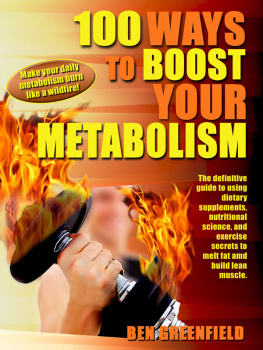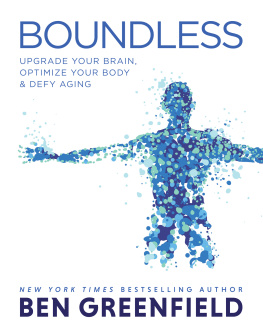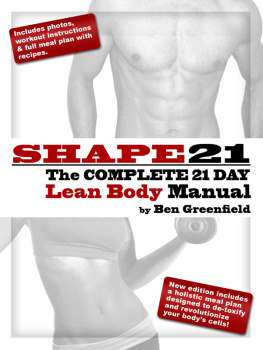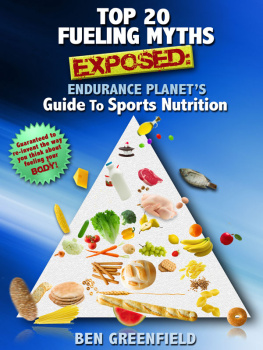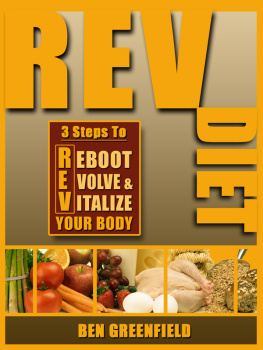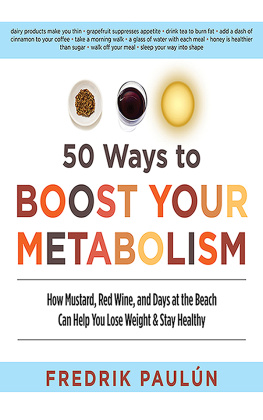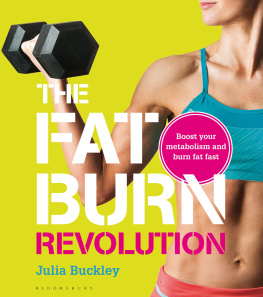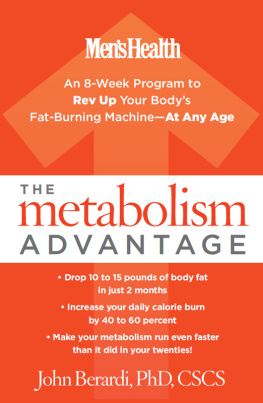Ben Greenfield - 100 Ways To Boost Your Metabolism
Here you can read online Ben Greenfield - 100 Ways To Boost Your Metabolism full text of the book (entire story) in english for free. Download pdf and epub, get meaning, cover and reviews about this ebook. year: 2008, publisher: CreateSpace Independent Publishing Platform, genre: Children. Description of the work, (preface) as well as reviews are available. Best literature library LitArk.com created for fans of good reading and offers a wide selection of genres:
Romance novel
Science fiction
Adventure
Detective
Science
History
Home and family
Prose
Art
Politics
Computer
Non-fiction
Religion
Business
Children
Humor
Choose a favorite category and find really read worthwhile books. Enjoy immersion in the world of imagination, feel the emotions of the characters or learn something new for yourself, make an fascinating discovery.
- Book:100 Ways To Boost Your Metabolism
- Author:
- Publisher:CreateSpace Independent Publishing Platform
- Genre:
- Year:2008
- Rating:4 / 5
- Favourites:Add to favourites
- Your mark:
- 80
- 1
- 2
- 3
- 4
- 5
100 Ways To Boost Your Metabolism: summary, description and annotation
We offer to read an annotation, description, summary or preface (depends on what the author of the book "100 Ways To Boost Your Metabolism" wrote himself). If you haven't found the necessary information about the book — write in the comments, we will try to find it.
100 Ways To Boost Your Metabolism — read online for free the complete book (whole text) full work
Below is the text of the book, divided by pages. System saving the place of the last page read, allows you to conveniently read the book "100 Ways To Boost Your Metabolism" online for free, without having to search again every time where you left off. Put a bookmark, and you can go to the page where you finished reading at any time.
Font size:
Interval:
Bookmark:
Prior to beginning any exercise program, you must consult with your physician. You must also consult your physician before increasing the intensity of your training. The information in this book is intended for healthy individuals. Any application of the recommended material in this book is at the sole risk of the reader, and at the readers discretion. Responsibility of any injuries or other adverse effects resulting from the application of any of the information provided within this book is expressly disclaimed.
Price World Publishing
www.PriceWorldPublishing.com
Copyright 2012 by Ben Greenfield
All rights reserved. Neither this book, nor any parts within it may be sold or reproduced in any form without permission.
eISBN: 9781619841321
Energy. |  |
Your body is always expending energy. It doesnt matter whether you are sleeping, performing a push-up, sitting at your desk, walking the dog or eating popcorn. Somehow your body must muster enough energy, through one process or another, to sustain life and perform the activities of daily living.
Some energy requiring processes are automatic. Your heart must beat. Your eyes must twitch. Your lung muscles must contract and relax. Your liver must process organic compounds. Your kidneys must filter your blood. While you have no direct control over these processes, there are dietary and lifestyle modifications you can make that affect how much energy your body automatically burns.
There are also voluntary energy requiring processes. You must fire the muscles in your legs to sit down in your desk chair, to move your fingers to clip the leash on the dog and to contract your gripping muscles to grab a handful of popcorn. Each of these actions requires energy.
All this energy is measured in tiny units called calories. Metabolism is defined as the caloric sum of all these chemical processes, whether automatic or voluntary, that must take place in order for the energy forming process to occur.
Technically, metabolism is divided into four components: resting metabolic rate (RMR), thermal effect of feeding (TEF), thermal effect of activity (TEA) and adaptive thermogenesis (AT).
Your resting metabolic rate (RMR) accounts for the largest portion of your metabolism, up to 75% of your total daily energy expenditure. RMR includes all the automatic processes your body must sustain in order to live: the action of your digestive, cardiovascular and hormonal systems, the maintenance of proper body temperature, the preservation of sensitive electrical gradients in your cells and the conductance of electrical transmissions through your nervous system.
Without your RMR you would cease to exist. However, in the presence of certain crucial factors outlined in this book, your RMR can be slightly enhanced in a way that not only maintains normal function but pushes the rate just slightly higher!
The TEF is the caloric sum of all the energetic processes required to digest, absorb, transport, metabolize and store your food. Believe it or not this can account for up to 10% of your energy expenditure. Portions of this book explain how the content and chemical structure of the foods you eat can increase or decrease the TEF.
The TEA is the easiest metabolic component to modify and accounts for up to 30% of the total daily energy expenditure depending on your level of physical activity.
If youre physically active youve already taken a step in the right direction toward increasing your TEA.
The 100 tips presented in this book will move you light years forward by supplying you with the knowledge of exactly which activities to perform, for how long and with what intensity to drive your TEA through the roof.
The final component of metabolism, the AT, is your bodys reaction system. Basically, your metabolism will make sensitive rate alterations in response to changes in the external or internal environment, such as physical or mental stress, hot or cold temperatures and changes in the bodys hormone levels. There are certain strategies outlined in this book that throw environmental curveballs at the AT, forcing the body to react and maintain a highly sensitive metabolism.
It is also possible to have an energy surplus. The Law of Conservation of Energy says that energy cannot be created or destroyed, it can only change form. Therefore, unused energetic compounds found in food are either extracted as waste products or stored for future use, usually as fat.
To avoid this unwanted energy storage, the metabolic strategy outlined in this book is three-fold:
1. Practice dietary techniques that eliminate the energy surplus.
2. Follow lifestyle guidelines that maximize energy expenditure.
3. Supplement with compounds that have been proven to optimize the bodys ability to use energy.
Energy comes from food. However, complex actions must take place inside your body for turkey, mashed potatoes and cranberries to become the energy needed to talk, stand, sit, walk and breathe. Your body must break the food into small pieces, then absorb and move them through the membrane of a tiny cell to be broken into even smaller pieces. These pieces then enter into a miniscule cellular component called the mitochondria. The mitochondria is the cells powerhouse. It is here that the electrical power of oxygen is harnessed to finally break that last tiny molecule of food apart and release energy!
There are thousands of crucial steps leading up to this eventual re-lease of energy, most of which require energy themselves. This energy is derived from the calories, nutrients, vitamins and minerals youve previously consumed and are combined with the oxygen you breathe. Any shortage of the necessary components results in a shortage of energy. Therefore, inadequate oxygen or inadequate food intake results in inadequate energy.
Inadequate energy results in a slow metabolism. This book not only tells you how to ensure adequate nutrients from your dietary and supplement intake, but also how to achieve adequate oxygen balance in your internal and external environments.
In the energy creation process, there are certain barriers to overcome. Take free radicals, for example. The more energy you require the more oxygen you must utilize. Occasionally oxygen can mutate and escape from the cell in the form of a free radical oroxidant. When these renegade oxygen molecules combine with other molecules in the body they can interrupt the processes associated with their host molecule.
Because they can interact with so many different molecules, free radicals can wreak serious havoc by altering DNA, destroying sensitive protective barriers around the cell and changing the fragile biochemical structures of proteins and fats. These disruptions and alterations of sensitive cellular processes can sabotage energy production. Even a small amount of damage to a cells outside receptors and membrane can severely alter the movement of compounds in and out of the cell, eventually killing the cell.
Another serious barrier to boosting your metabolism is blood sugar stabilization. After consumption of a carbohydrate-rich meal, your digestive system breaks down the carbs into tiny glucose molecules.
Once these molecules enter the bloodstream they trigger the release of insulin by an organ called the pancreas. Insulin ensures that the glucose is delivered to necessary tissues for energy. When these energy stores are full any excess glucose still in the bloodstream or digestive tract is easily converted to fat.
Unfortunately, most of us are walking around with chronically elevated insulin levels because of excess energy consumption, especially in the form of simple sugars. Constant exposure to high amounts of insulin results in a condition called Metabolic Syndrome.
Next pageFont size:
Interval:
Bookmark:
Similar books «100 Ways To Boost Your Metabolism»
Look at similar books to 100 Ways To Boost Your Metabolism. We have selected literature similar in name and meaning in the hope of providing readers with more options to find new, interesting, not yet read works.
Discussion, reviews of the book 100 Ways To Boost Your Metabolism and just readers' own opinions. Leave your comments, write what you think about the work, its meaning or the main characters. Specify what exactly you liked and what you didn't like, and why you think so.

